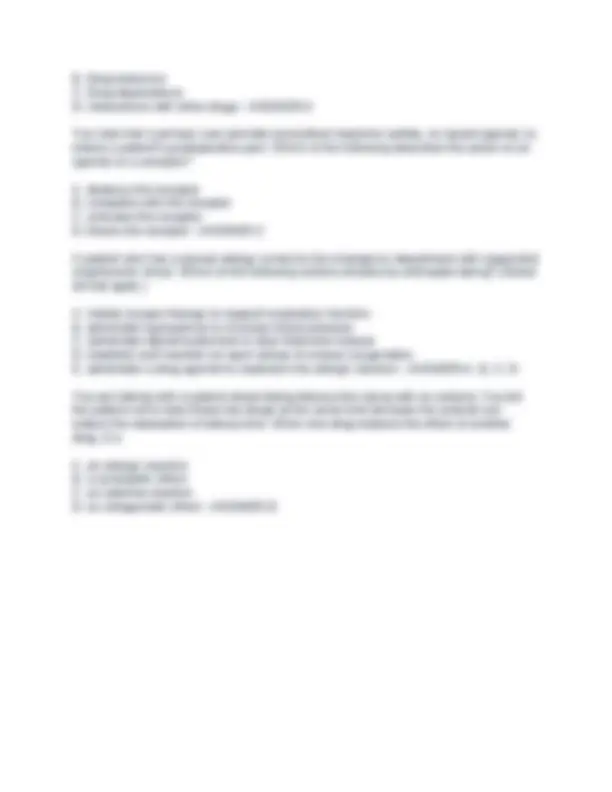



Study with the several resources on Docsity

Earn points by helping other students or get them with a premium plan


Prepare for your exams
Study with the several resources on Docsity

Earn points to download
Earn points by helping other students or get them with a premium plan
Community
Ask the community for help and clear up your study doubts
Discover the best universities in your country according to Docsity users
Free resources
Download our free guides on studying techniques, anxiety management strategies, and thesis advice from Docsity tutors
Primary care providers prescribe drug dosages for children using which of the following information? (Select all that apply) A. Body surface area B. Age C. Weight D. Drug properties E. Developmental level - ANSWER-A, B, C, D An older adult patient may be at risk for drug toxicity due to which of the following physiologic changes associated with aging? A. reduced hepatic blood flow B. increased glomerular filtration rate C. reduced body fat D. increased gastric mobility - ANSWER-A You are helping a patient learn how to give himself an insulin injection. Which of the following is the best method for evaluating effective learning? A. verbally quiz a family member B. instruct the client to complete a written test C. have the client demonstration an insulin injection D. ask the client several key questions about the procedure - ANSWER-C
Typology: Exams
1 / 2

This page cannot be seen from the preview
Don't miss anything!


Primary care providers prescribe drug dosages for children using which of the following information? (Select all that apply) A. Body surface area B. Age C. Weight D. Drug properties E. Developmental level - ANSWER-A, B, C, D An older adult patient may be at risk for drug toxicity due to which of the following physiologic changes associated with aging? A. reduced hepatic blood flow B. increased glomerular filtration rate C. reduced body fat D. increased gastric mobility - ANSWER-A You are helping a patient learn how to give himself an insulin injection. Which of the following is the best method for evaluating effective learning? A. verbally quiz a family member B. instruct the client to complete a written test C. have the client demonstration an insulin injection D. ask the client several key questions about the procedure - ANSWER-C A patient asks you about the difference between a generic drug and a trade- or brand- name drug. You explain that a generic drug (Select all that apply. A. Has the potential for abuse and dependence B. Has the same chemical composition as the brand-name drug C. May have several brand names D. Are usually less expensive than a brand- name drug E. May have several generic names - ANSWER-B, C, D A patient with glaucoma asks you about taking oxybutynin (Ditropan), a muscarinic antagonist, to manage an overactive bladder. You explain that glaucoma is a contraindication for taking oxybutynin. Patients should not take a drug that is contraindicated because of its potential for which of the following? A. Serious adverse reactions
B. Drug tolerance C. Drug dependence D. Interactions with other drugs - ANSWER-A You note that a primary care provider prescribed morphine sulfate, an opioid agonist, to relieve a patient's postoperative pain. Which of the following describes the action of an agonist on a receptor? A. destroys the receptor B. competes with the receptor C. activates the receptor D. blocks the receptor - ANSWER-C A patient who has a peanut allergy comes to the emergency department with suspected anaphylactic shock. Which of the following actions should you anticipate taking? (Select all that apply.) A. Initiate oxygen therapy to support respiratory function B. administer epinephrine to increase blood pressure C. administer diphenhydramine to stop histamine release D. establish and maintain an open airway to ensure oxygenation E. administer a drug agonist to neutralize the allergic reaction - ANSWER-A, B, C, D You are talking with a patient about taking tetracycline along with an antacid. You tell the patient not to take these two drugs at the same time because the antacid can reduce the absorption of tetracycline. When one drug reduces the effect of another drug, it is A. an allergic reaction B. a synergistic effect C. an adverse reaction D. an antagonistic effect - ANSWER-D